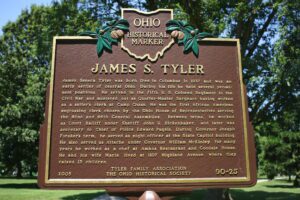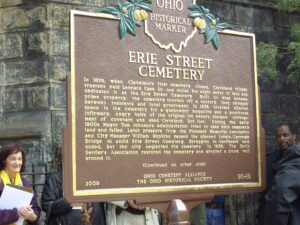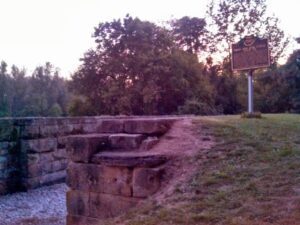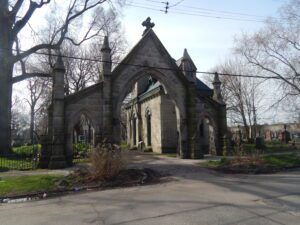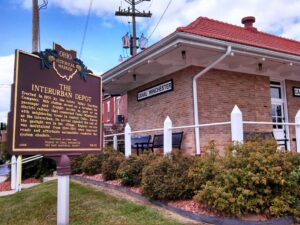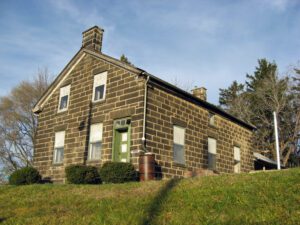, OH
James Seneca Tyler was born free in Columbus in 1837 and was an early settler of central Ohio. During his life he held several prominent positions. He served in the Fifth U.S. Colored Regiment in the Civil War and mustered out as Quarter-Master Sergeant having worked as a sutler’s clerk at Camp Chase. He was the first African American engrossing clerk chosen by the Ohio House of Representatives serving the 62nd and 66th General Assemblies. Between terms, he worked as Court Bailiff under Sheriff John U. Rickenbaker, and later was secretary to Chief of Police Edward Pagels. During Governor Joseph Foraker’s term, he served as night officer at the State Capitol building. He also served as Attache under Governor William McKinley. For many years he worked as a chef at Ambos Restaurant and Goodale House. He and his wife Maria lived at 1107 Highland Avenue where they raised 13 children.
, OH
In 1826, when Cleveland’s first cemetery closed, Cleveland village trustees paid Leonard Case Sr. one dollar for eight acres of land and dedicated it as the Erie Street Cemetery. Built on what became prime property, the cemetery touched off a century long struggle between residents and local government. In 1836, trustees allotted space in the cemetery for a gunpowder magazine and a poorhouse infirmary. Angry heirs of the original lot owners claimed infringement of covenant and sued Cleveland, but lost. During the early 1900s Mayor Tom Johnson’s administration tried to take back cemetery land and failed. Later pressure from the Pioneers’ Memorial Association and City Manager William Hopkins caused the planned Lorain Carnegie Bridge to avoid Erie Street Cemetery. Struggles to confiscate land ended, but the city neglected the cemetery. In 1939, The Early Settler’s Association restored the cemetery and erected a stone wall around it. (continued on other side)
, OH
The Ohio and Erie Canal Lock 22, constructed from 1830-1831, is the only canal lock in Groveport. Constructed by W.H. Richardson as part of his $2,937 bid to build section 52 of the canal, the sandstone lock is 117 feet long and ten feet deep and has a sixteen foot wide channel. Its purpose was to raise and lower canal boats to meet the changing terrain. The canal’s presence helped fuel commercial and population growth in Groveport in the 19th century by providing a fast and reliable form of transportation to move people, goods, and services to and from the Ohio frontier. It was also a source of recreation as residents used its waters for fishing, row boating, and ice skating. The canal basin at the western end of Lock 22 was a favorite spot for ice skating parties.
, OH
In January 1836, Barber and Lord sold a six-acre parcel for $160 that was to be used “forever as a public burying ground.” When Ohio City incorporated, the township cemetery became the city cemetery. Ohio City’s council established the cemetery’s rules and regulations, appointed a sexton, arranged for the ground to be platted, and purchased a hearse. After annexation by Cleveland, the cemetery became known as “the west side cemetery” and, later, the Monroe Street Cemetery. Under Cleveland’s charge, the cemetery was landscaped, protected by patrolmen, and fenced to keep out wandering hogs. Until the late 1890s, Monroe Street was the only public cemetery on Cleveland’s west side. Architect Joseph Ireland designed the cemetery’s Gothic Revival gateway arch (1874). Architect Walter Blythe designed the cemetery’s gatehouse, also in the Gothic Revival style (1876).
, OH
Erected in 1905 by the Scioto Valley Traction Company, this station served as a terminal for passenger and freight service as part of an electric railway that connected Canal Winchester with neighboring towns in central Ohio. Known as the interurban, its arrival signaled the end of the gaslight era in the village. Regular service was maintained from 1904-1930 when improved roads and affordable automobiles rendered the system obsolete. [continued on other side]
, OH
The Henninger Homestead was founded in an era when local quarries provided raw materials for the construction of the Ohio and Erie Canal. Bavarian immigrants Philip and Sophia Henninger came to Parma Township in 1840. Although Philip was a skilled tinsmith, he soon established a quarry on his property to supply sandstone for the breakwall of Cleveland’s harbor in Lake Erie, canal locks, and other building projects. In 1849, the Henningers replaced their log home with this Greek Revival house using stone from their quarry. Blocks at its base measure 30″ thick while upper walls are 14″ thick. Abandoned in 1988, the site was saved from demolition in 2003. The house and nearby carriage barn stand as the oldest buildings in the City of Parma.
, OH
Over its 145 years, the Old Canal Winchester School building played a significant role in the community. The original four-room building opened in 1862 and its first high school class graduated seven in 1886. Canal Winchester’s growth is reflected in the school’s several additions, the first of which was in 1875. Other expansions include a separate high school building in 1909, a three-story connector in 1929 between the 1862 and the 1909 buildings, and elementary school wings in 1956 and 1967. The school was also the site of continuing education and vocational classes for adults in the 1930s and 1950s, agricultural programs for veterans after World War II, and a cannery from the time of that war to 1952. The school was added to the National Register of Historic Places in 2017 and it remains the district’s administrative center and a community gathering space.
, OH
Civil unrest rocked the Hough neighborhood for five nights during the summer of 1966.When the white owners of the Seventy-Niners Cafe refused to serve a Black customer a glass of water, a sign bearing a racial epithet subsequently appeared outside the bar. Decades of institutionalized racial practices that had caused Hough’s substandard and overcrowded housing, high unemployment, economic exploitation, lack of access to quality education, and systemic police harassment sparked an urban uprising in response on July 18. Angry crowds gathered outside the bar only to be confronted by the owners brandishing firearms. When the police belatedly responded, tensions escalated into targeted firebombing, looting, and vandalism. On Tuesday night, July 19, Cleveland’s Mayor Ralph Locher requested that the Ohio National Guard restore order. (Continued on other side)


